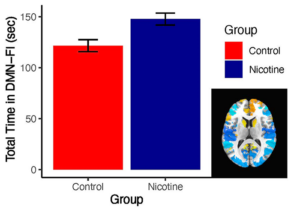 Hot Off the Press – January 30, 2024
Hot Off the Press – January 30, 2024
Published in JAMA Network Open by Annika Quam and Amy Janes et al. from the NIDA IRP Cognitive and Pharmacological Neuroimaging Unit.
Summary
As a primary cause of preventable death, nicotine dependence remains a significant public health concern. While there are several medications that help people quit smoking, many individuals relapse despite receiving support. To suggest new directions for treatment, our lab works to understand how brain function and nicotine use are related. Here, we used an fMRI imaging technique called temporal dynamics, which allows us to measure brain function when someone is resting in the scanner. When comparing brain function between those who do and do not smoke, we found that individuals who do smoke spent more time in the frontoinsular default mode network (FI-DMN) state. This is relevant because engagement of FI-DMN brain regions has been linked with ruminating on how one feels, craving, and the maintenance of nicotine dependence. We show that even when someone is not doing anything, nicotine dependent individuals spend more time in a brain state linked with continued nicotine use. Moving a step further, we asked whether a history of childhood trauma and related emotion dysregulation would impact our results. This is important because childhood trauma exposure places one at risk for developing emotion dysregulation and substance use. We found that trauma-related emotion dysregulation, specifically when individuals have difficulty identifying and expressing emotions, was associated with spending less time in the FI-DMN. But, this was only true for those who use nicotine. While our group level results showed that those who use nicotine spent more time in the FI-DMN, having greater trauma-related emotional dysregulation is linked with less time in this same network. Thus, considering trauma-related factors revealed an alternative neurobiological underpinning of nicotine use which was not seen when only comparing those who do and do not smoke. Our findings also suggests that too much or too little FI-DMN function may correspond with different aspects of emotional dysregulation (i.e., too much or too little focus on emotional states), which both contribute to nicotine use.
Publication Information
Childhood Trauma, Emotional Awareness, and Neural Correlates of Long-Term Nicotine Smoking Journal Article
In: JAMA Netw Open, vol. 7, no. 1, pp. e2351132, 2024, ISSN: 2574-3805.
